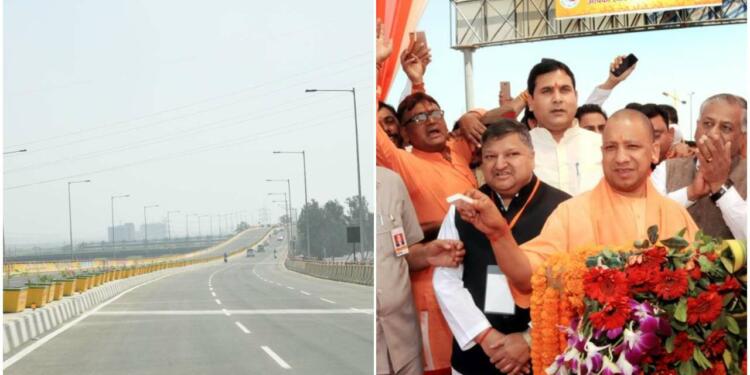The Uttar Pradesh assembly elections are scheduled to be held early next year. While the left-liberal, Lutyens and Khan media uses the stale, old tropes of defaming the bhagwa-clad leader to propel the opposition, Chief Minister Yogi Adityanath is quietly transforming the state infrastructure and in turn the lives of the voters of the most populous state of the country.
Roads are the lifeline of a country and Yogi has made it his mission to connect Uttar Pradesh and its distant villages and towns to the mainstream. Reportedly, the ambitious 340-kilometre Puravanchal expressway – the longest across the country is expected to be opened later this month. The expressway will negotiate through the districts of Barabanki, Amethi, Sultanpur, Ayodhya, Ambedkar Nagar, Azamgarh and Mau. It will be inaugurated by none other than Prime Minister Narendra Modi.
However, Yogi Adityanath is not the one to sit on his laurels and thus the upcoming projects, viz. the 594-km Ganga expressway, the 296-km Bundelkhand expressway and 91-km Gorakhpur Link are expected to transform UP into the state with a total expressway length that nearly eclipses the national length. Currently, the total expressway network in India is around 1,822 km while UP would have a total network of 1,788 km of expressways, once completed.
The Uttar Pradesh Expressways Industrial Development Authority (UPEIDA), the agency set up by the state government to steer its expressway expansion programme has been working at a breakneck speed to complete the modern engineering marvels.
The four-lane (expendable to six) Rs 14,716 crore Bundelkhand Expressway is likely to be completed by March next year, almost a year before schedule. It will connect the backward districts of the region such as Chitrakoot, Banda, Mahoba, Hamirpur, Jalaun, Auraiya and Etawah. While Yamuna Expressway was conceived in 2001, it was only completed in 2012, taking well over a decade to be built.
However, the express pace of the construction of the Bundelkhand expressway can largely be attributed to Yogi’s incessant desire to transform the state.
UPEIDA Chief Executive Officer Awanish Awasthi told the Print that change in work culture was because of the push given to infrastructure development by CM Adityanath, “UPEIDA was empowered to make quick decisions, be it land acquisition, getting forest and environment clearance, shifting utilities, etc. We managed to get environment clearance for Purvanchal and Bundelkhand expressways in record time,”
According to the publication’s report, UPEIDA is also working on creating industrial hubs around the area. Work is also underway on the defence corridor project, where land is being allotted to defence companies to set up their manufacturing unit.
On Gorakhpur Link Expressway, the Project Monitoring Group (PMG) has been informed that 26.7 per cent of work has been completed till July 31. The Link expressway will connect Gorakhpur, Azamgarh, Ambedkarnagar and Sant Kabirnagar, and the scheduled date for the completion of the project is April 2022. The main carriageway of Expressway will be opened to traffic by March 2022.
Read More: Yogi govt. plans expressway to every region of UP by 2022
In the case of the proposed Ganga expressway, PMG was informed that 90.74 per cent of 7287.93 hectares has been purchased till July 31. The 594km-long expressway will start from NH-334 in Meerut and end at Prayagraj bypass on NH-2. The six-lane expressway, expandable up to eight lanes, will pass through Hapur, Bulandshahar, Amroha, Sambhal, Badaun, Shahjahanpur, Hardoi, Unnao, Rae Bareli and Pratapgarh. The eight-lane project will cost nearly Rs 36,000 crore
Giving an update on the land acquisition, Yogi recently stated, “The state government had decided to create a 594 km-long expressway between Prayagraj and Meerut. A total of 93% of the land acquisition process is complete for that,” said Yogi Adityanath.
Combined with the Yamuna Expressway, which connects Greater Noida to Agra, the Ganga Expressway would ensure a high-speed road corridor linking Lucknow to Delhi and the National capital Region (NCR),
While Yogi focuses on infrastructure development as his major poll plank, the depleted opposition has turned the clock backwards. Instead of its usual Muslim appeasement style of politics, parties like SP and BSP are targeting the Brahmin vote bank after construction of Ram Mandir started.
As reported by TFI, BSP last month started a Brahmin conference in the holy city of Ayodhya, aimed at bringing the Brahmin community into the fold. Mayawati’s Brahmin outreach program was led by party general secretary and Brahmin face Satish Chandra Mishra who paid obeisance at the makeshift shrine of Ram Lalla in the temple city before kickstarting the “Sammelan’. But the Sammelan is a failed approach. Mere photo-ops will not entice Brahmin voters or for that matter, any voter.
While the liberal media doesn’t call out Mayawati for her vote bank politics, it sure does not waste a heartbeat coming after Yogi when he changes the name of a particular city, based on expert advice, historical accuracy and evidence. Moreover, the media fails to highlight the gargantuan scale of infrastructure being developed in the state, which five years ago used to be a pipe dream.































